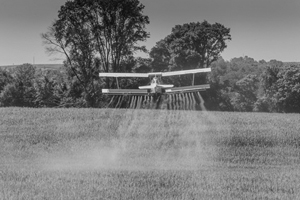Rachel Carson and Neil Gorsuch
Unlike Supreme Court Justice William O. Douglas, who promoted Rachel Carson’s Silent Spring and garnered support for her when she testified before Congress, Supreme Court Justice Neil Gorsuch is no defender of the environment. Already, Gorsuch has ruled that environmental organizations should not be able to join in lawsuits with the government when defending laws and regulations that the organizations support. Additionally, Gorsuch will likely not follow lead of the Chevron case, which left interpretation and implementation of broad environmental laws to the discretion of the EPA. In fact, Gorsuch has already denied standings to citizens concerned about environmental degradation. Had Gorsuch been on the bench when Rachel Carson was alive, Musil imagines, we may not have had Silent Spring or even a modern environmental movement — a concerning thought for the future of human health and the planet.
 Neil Gorsuch looks like a Supreme Court justice, right? Distinguished, handsome, trim, trim suit, silver hair, silver speaking tones, male, white. In his opening statement to the Senate Judiciary Committee, this Harvard Law School graduate presented himself as just a simple fly fisherman from the West. Above politics. Calls ‘em as he sees ‘em. Nothing but the Constitution at his side.
Neil Gorsuch looks like a Supreme Court justice, right? Distinguished, handsome, trim, trim suit, silver hair, silver speaking tones, male, white. In his opening statement to the Senate Judiciary Committee, this Harvard Law School graduate presented himself as just a simple fly fisherman from the West. Above politics. Calls ‘em as he sees ‘em. Nothing but the Constitution at his side.
So environmentalists have nothing to fear from this guy. It’s OK if Democrats cave and let him sit and opine for the next forty years. Well, not so fast.
Despite his fly fishing, Gorsuch is no defender of the environment. He has already ruled, for example, that environmental organizations should not be able to join in lawsuits with the government when it is defending regulations or rules that they approve of. When the Sierra Club and the Center for Biological Diversity sought to join in a suit defending a Forest Service rule limiting where off-road vehicles could drive, Gorsuch wrote a dissent saying that the groups had no dispute with the Forest Service, so adding them to the case would simply complicate the judicial process.
Gorsuch’s rulings as a Federal judge clearly indicate that he would likely prevent environmental organizations from bringing some environmental lawsuits forward at all. Rebecca Leber pointed out in a thorough review for Mother Jones that Gorsuch would likely not follow the lead of the pivotal Chevron case. In Chevron, Justice John Paul Stevens wrote that the Supreme Court leaves the interpretation and implementation of broad environmental laws like the Clean Air Act to the EPA, rather than interpret what the Congress might have meant. Gorsuch disagrees and sees the result of Chevron as improperly increasing the power of the Federal government.
Since Chevron is the pillar on which Obama climate change regulations stand, with Judge Gorsuch elevated to the Supreme Court, we can reasonably expect attempts to undercut both the Clean Air Act and policies like the Clean Power Plan. There is still more to worry about the anti-environmental proclivities of Judge Gorsuch. He has already refused to grant standing to some citizens and groups concerned about damage to the environment, so such cases might not even be allowed to be heard before the Supreme Court.
Had Judge Gorsuch been on the bench when Rachel Carson was alive, we might not have had Silent Spring at all — or the modern version of the environmental movement concerned with environmental assaults on human health, as well as birds and animals.

Rachel Carson speaking before the Senate Government Operations subcommittee studying pesticide spraying. United Press International photo, 1963. Prints and Photographs Division of the Library of Congress.
Rachel Carson’s Silent Spring surely brought the environment and the perils of DDT and other pesticides to broad public attention and to policy makers in the Kennedy era. But it was a lawsuit brought by Marjorie Spock and her fellow wealthy North Shore Long Islanders that reached the Supreme Court that caught the attention of William Shawn, the editor of the New Yorker, who had serialized Carson’s 1951 mega-best seller, The Sea Around Us. Spock was a progressive Waldorf School teacher who, with her partner, Polly Richards, had many acres of organic gardens on their estate.  When the government repeatedly, and needlessly, sprayed DDT across their property from a small plane, Spock organized the neighbors and sued. Shawn initially sought essayist E.B. White to write about this pesticide controversy. But White recommended Rachel Carson as better suited to the task. The rest is history. But that history rests on the Spock lawsuit, much of which the Supreme Court denied, while holding that the plaintiffs should have been allowed injunctive relief to prevent the spraying before it began.
When the government repeatedly, and needlessly, sprayed DDT across their property from a small plane, Spock organized the neighbors and sued. Shawn initially sought essayist E.B. White to write about this pesticide controversy. But White recommended Rachel Carson as better suited to the task. The rest is history. But that history rests on the Spock lawsuit, much of which the Supreme Court denied, while holding that the plaintiffs should have been allowed injunctive relief to prevent the spraying before it began.
Spock went on to be a major confidante and source of research, legal cases, and information for Rachel Carson while she was writing Silent Spring. Together, along with many others, Spock and Carson were part of the Committee Against Mass Poisoning, an advocacy group of which Spock was the linchpin.
Perhaps in evaluating Neil Gorsuch, we should compare him, not to the rabidly reactionary Justice Antonin Scalia, but to Supreme Court Justice William O. Douglas who dissented in the Marjorie Spock case, arguing for the plaintiffs. Justice Douglas, like Gorsuch, was a Westerner, but an actual environmentalist. He wrote on wilderness, was a Board member of the Sierra Club, and hiked the entire 180 miles of the C&O Canal at a rapid pace with reporters and influential Washingtonians gasping in his wake in order to save what is now a national park from being turned into a highway alongside the Potomac River.
And it was Justice Douglas whom Rachel Carson’s literary agent, Marie Rodell, arranged to have write a positive review of Silent Spring for the Book-of-the Month Club. Douglas wrote that all Americans must read this now environmental classic. He called it “the most revolutionary book since Uncle Tom’s Cabin” and set off a wave of adulation for Carson by Senators when she testified before Congress. A number of them, paraphrasing Abe Lincoln when he met Harriet Beecher Stowe, called her “the little lady that started it all.”
It is hard to imagine Neil Gorsuch giving rave reviews to Rachel Carson or to Silent Spring or hiking with reporters to preserve the C&O Canal. He may look the part of an old-time Supreme Court Justice, but William O. Douglas he is not.







